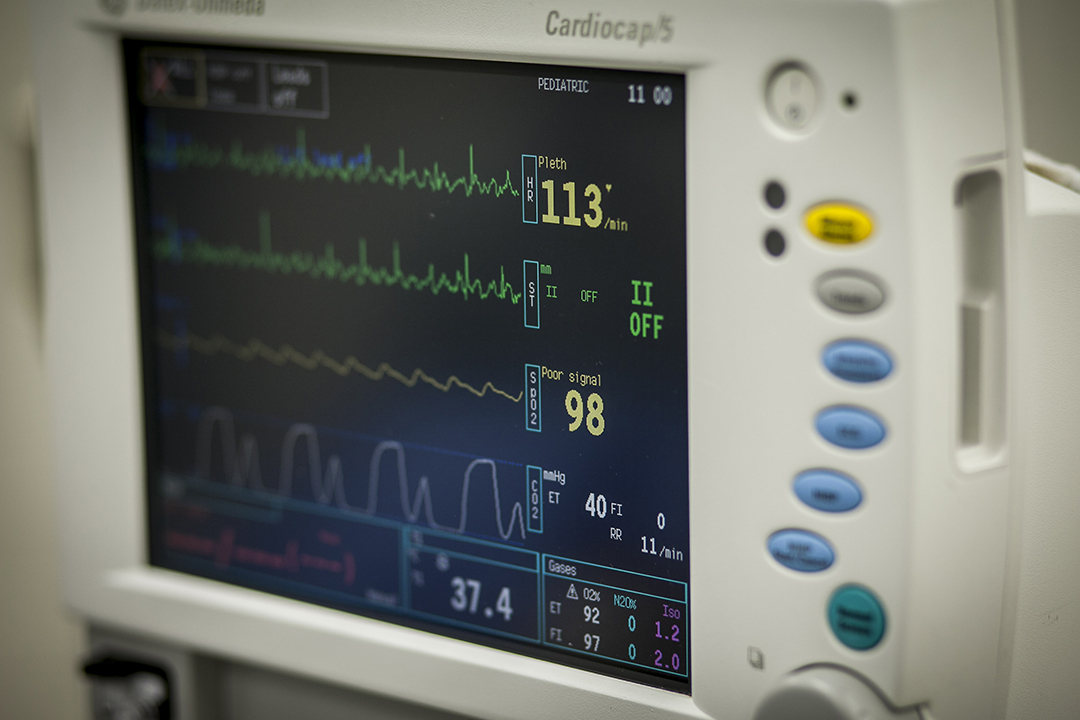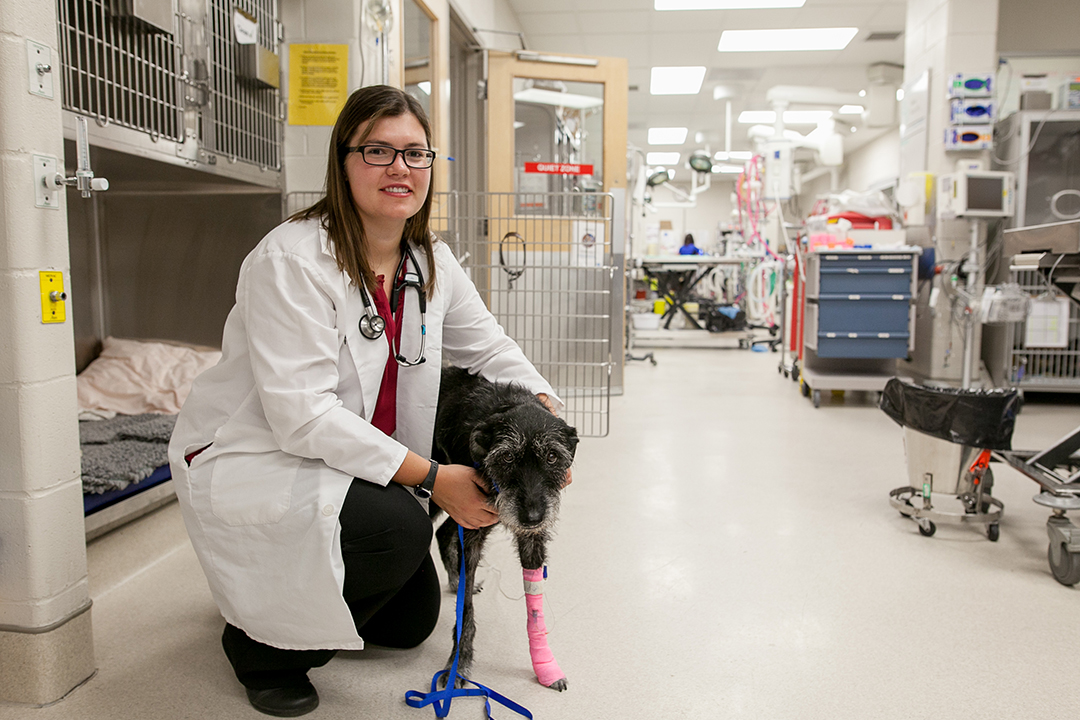
Clinical team maintains critical veterinary services
As the only 24-hour veterinary emergency and critical care service available in Saskatoon, the clinical team at the Western College of Veterinary Medicine’s Veterinary Medical Centre (VMC) cares for some of the most ill or injured animals in the area.
By Nykole KingThe veterinary teaching hospital receives some of the emergency cases that general veterinary practices aren’t equipped to handle or are too busy to see and provides unique services that aren’t available elsewhere in the province, such as MRI (magnetic resonance imaging) scans and other specialized diagnostic procedures. The hospital’s clinical team also receives patients from referring veterinarians in Western Canada.
“It’s not unusual for other clinics to recommend to owners to come to us because they figure the patient may need 24-hour care or an advanced work up,” says Dr. Jennifer Loewen, a board-certified veterinary specialist in emergency and critical care.
Pressure is an accepted part of the job in the hospital’s intensive care unit (ICU), but since the COVID-19 pandemic began in March 2020, the challenges facing the emergency and critical care team have dramatically increased.
“With COVID-19, there’s been a lot of burn out going on, especially from my standpoint in the emergency and ICU areas,” says Dr. Rebecca Mycock, a clinical associate in the VMC’s emergency and critical care service. “(So we’ve been) trying to support each other and help each other out when you see that in your coworkers.”
When the entire province of Saskatchewan was under emergency measures during the first months of the COVID-19 pandemic, veterinary clinics reduced their services to limit the spread of the SARS-CoV2 virus among staff members. While the VMC had to put a hold on its regular clinical services, the hospital continued accepting the growing number of emergency and urgent cases.

Early pandemic response
By using rotating eight-hour shifts of smaller staff cohorts, a phone triage system and other innovative steps, the hospital continued providing essential animal care to thousands of animals during the first few months of the pandemic.
To minimize contact between staff members, the VMC divided the entire staff into six groups with each team of people working the same eight-hour shifts. Each cohort included registered veterinary technologists, clinicians, animal attendants, receptionists and others who maintain the daily operations of the VMC to ensure clinical knowledge and experience were well dispersed among the groups.
While it was challenging, the clinical teams learned to adapt and organize themselves more effectively. For example, when a new team came on shift at the hospital, they gathered in one of the college’s large lecture theatres and reviewed the current cases that would be transferred over to them at the start of their shift.
“It’s forced us to reevaluate some of the ways that we have been doing things and how we can change and adjust as we go,” Loewen says.
Another positive outcome was that clinical team members worked with some staff members who they had never interacted with before during regular operations.
“It really helped develop a better team atmosphere and [an] idea of what all the departments had to deal with each day and not just your one area,” says Danielle Mierau, a registered veterinary technologist at VMC.
Critical care still challenging
By July 2020, the veterinary teaching hospital was able to resume its regular clinical services along with most of its referral services. Between August 2020 and April 2021, fourth-year veterinary students also completed their clinical rotations in all of the different clinical services — including emergency and critical care. COVID-related restrictions altered some aspects of the students’ experience in the hospital’s emergency and intensive care unit (ICU), but overall, Loewen says they were still able to gain valuable learning experiences and to see a wide variety of cases.
While most of the VMC’s clinical service groups have been able to address the backlog of cases in the past 10 months, the hospital’s emergency and critical service is still experiencing record high caseloads.
“I think general practices in the city are overwhelmed with the number of cases they’re seeing, so a lot more things are getting deferred to come to us through emergency,” says Mycock. The summer months tend to be busier for the VMC’s emergency service, but Mycock says that the hospital’s emergency caseload during the past 12 months has been the largest that she has ever experienced.
Larger numbers of small animal emergency cases have a domino effect on other patients in the VMC’s Small Animal Clinic. Elective procedures have had to be rescheduled since incoming emergency and critical care cases take priority over spay and neuter surgeries and other non-urgent procedures.
“We’ll have to bump them a day or two because we just don’t have the staff, the surgery suites, the time in the day to get through everything. And I think that that can be really frustrating, especially for owners,” says Mierau, who is also a certified veterinary technician specialist in emergency and critical care. “But because this is emergency, we have certain things that can’t wait.”
While owners are waiting in their vehicles to have their pets seen for a minor emergency or a routine procedure, they don’t see the busy operations going on in the emergency and critical service where every second is vital for incoming emergency cases.
Nadine Schueller, the VMC’s former director of clinical care, likens the situation to when parents need to take their child to the emergency room at a human hospital.
“Our team prioritizes each patient by critical need. Behind the scenes, these doctors, RVTs and staff are working hard to ensure all pets get the best care,” says Schueller, who is also trained as an RVT.
Unfortunately, Schueller says there’s a North American-wide shortage of both veterinarians and RVTs — a situation that creates additional stress and strain on veterinary clinics and hospitals.
“In Saskatoon and area, the WCVM Veterinary Medical Centre is the emergency (after-hours) hospital for over 25 [veterinary] clinics and this creates many, many patients that come through the doors,” says Schueller. “We hope people understand the wait is due to us taking care of a more critical patient.”
The team at the VMC appreciates the public’s patience with the situation, especially when the team’s capacity is affected any time a clinical team member experiences COVID-19 symptoms and cannot come to work.
While the team can still carry on if one individual becomes ill and stays home as a precaution, the worst-case scenario would be if a large part of the emergency and critical team had to self-isolate because of potential exposure to COVID-19.
“We managed to make it through a full year without a workplace or student outbreak, due to staff diligence and care,” says Schueller.
In late April, several positive COVID-19 cases at the veterinary teaching hospital prompted the Saskatchewan Health Authority to declare an outbreak at the facility. The hospital’s outbreak was declared officially over on June 3.
“With this our resources and staff were limited, and staff kept going above and beyond to ensure patient care,” says Schueller, who describes the emergency team and ICU team as “the backbone of our hospital” throughout the COVID-19 pandemic.
“While referrals and specialty services can reduce their caseload by limiting their appointments, the emergency service continually must roll with whatever comes their way and they have been incredibly busy this past year.”
